Revealing the World of Sharks: From Ancient Megalodon to Modern Species
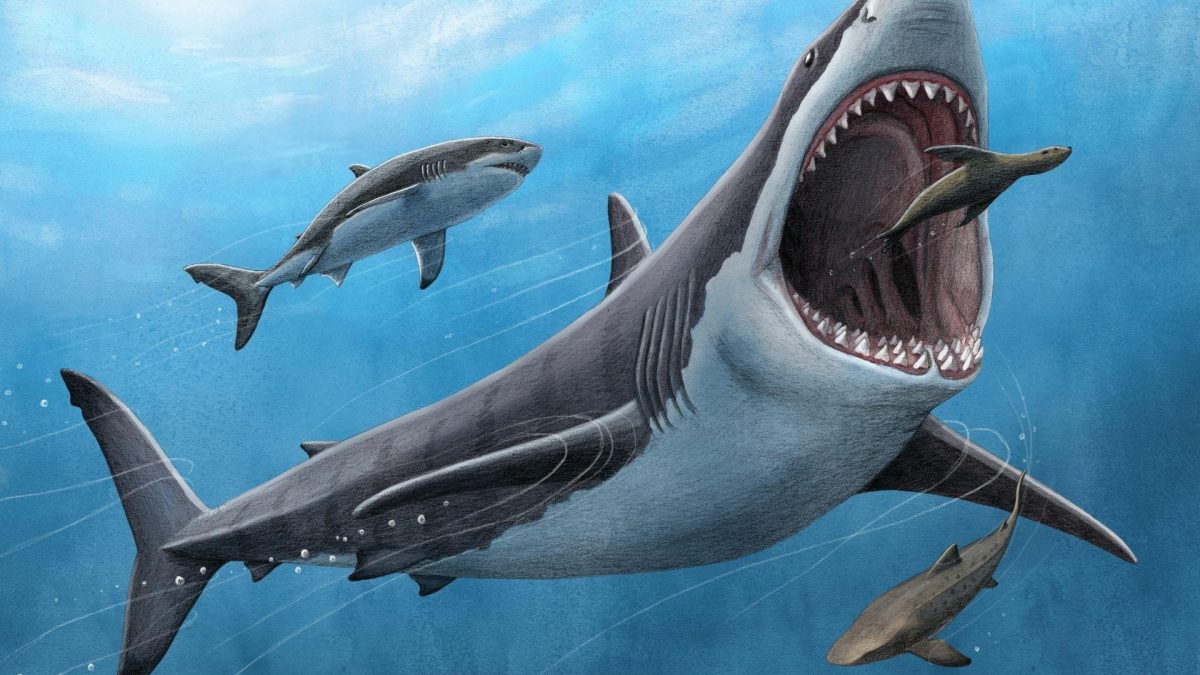
Megalodon illustration (Photo Credit : Alex Boersma/PNAS)
Sharks have inhabited Earth's oceans for millions of years, long before dinosaurs appeared on land. The oldest shark fossils found date back to the Devonian period, about 400 million years ago. At that time, sharks had already become the dominant predators in the oceans.
One of the most famous prehistoric shark species is the Megalodon (Carcharocles megalodon). Megalodon was one of the largest marine predators that ever existed, even larger than the modern great white shark.
Some interesting facts about Megalodon:
- It is estimated to have reached lengths of 18 meters, much larger than the modern great white shark, which only reaches 6 meters.
- It had large teeth, up to 17 cm, capable of crushing large prey such as whales and other giant marine animals.
- It is estimated to have lived during the Miocene to Pliocene periods, about 23 million years ago to 2.6 million years ago.
- It went extinct around 2.6 million years ago, presumably due to climate change and competition with new predators like the modern great white shark.
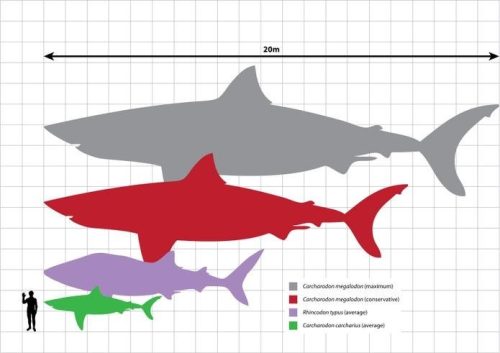
Size comparison of megalodon and modern sharks (Photo Credit : Scarlet23)
Besides Megalodon, there are also several other well-known prehistoric shark species, such as:
- Helicoprion : An ancient shark with uniquely spiral-shaped teeth.
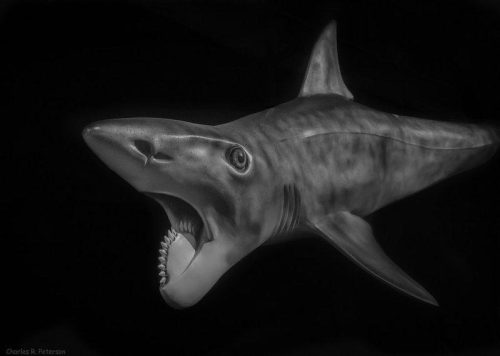
Helicoprion reconstruction (Photo Credit : Charles Peterson)
- Stethacanthus : An ancient shark with a structure resembling an anvil on top of its head.
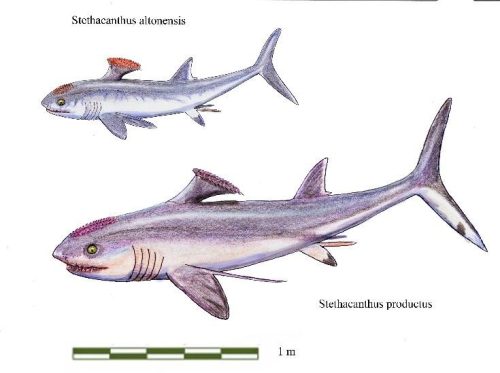
Reconstruction of two species of Stethacanthus (Photo Credit : DiBgd)
- Cladoselache : One of the oldest ancient sharks, estimated to have lived around 360 million years ago.
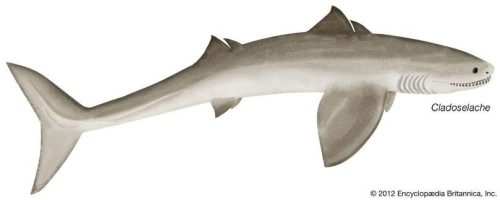
Cladoselache reconstruction (Photo Credit : Encyclopædia Britannica, Inc.)
Shark Classification
Kingdom : Animalia
Phylum : Chordata
Class : Chondrichthyes (Cartilaginous Fish)
Order : Selachii (Sharks)
Family :
- Carcharhinidae (Reef Sharks)
- Sphyrnidae (Hammerhead Sharks)
- Rhincodontidae (Whale Sharks)
- and others
Genus : There are various genera of sharks within each family, such as Carcharhinidae, Sphyrnidae, Lamnidae, Rhincodontidae, and others.
Species : There are hundreds of shark species distributed worldwide, including in Indonesian waters, such as:
- Carcharhinidae (Reef Sharks) : Blue Shark, Silky Shark, Blacktip Reef Shark
- Sphyrnidae (Hammerhead Sharks) : Scalloped Hammerhead, Great Hammerhead
- Lamnidae (Mackerel Sharks) : Great White Shark, Goblin Shark, Mako Shark
- Rhincodontidae (Whale Sharks) : Whale Shark
Sharks in Indonesia
As an archipelago nation bordered by the Indian Ocean and the Pacific Ocean, Indonesia is home to a diverse range of shark species. Some species that can be found in Indonesian waters include:
- Whale Shark (Rhincodon typus)
The whale shark is a giant shark species inhabiting warm oceans worldwide, including Indonesian waters. As the largest shark in the world, the whale shark can reach lengths of up to 12 meters and weigh over 20 tons. Despite its enormous size, the whale shark is relatively gentle and rarely poses a threat to humans.
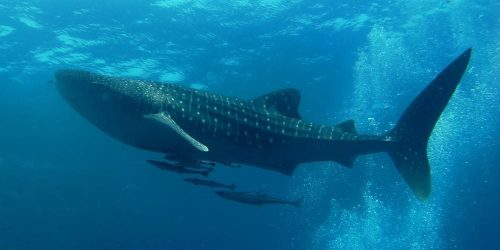
Whale shark at the Andaman sea (Photo Credit : Abe Khao Lak)
Whale sharks feed by filtering plankton, krill, and small fish from the water using their wide mouths. With slow and calm swimming movements, they utilize small scales on their bodies to help filter their prey. Whale sharks are also known as migratory species, moving around to follow the movement of plankton and other food sources.
- Hammerhead Shark (Sphyrna spp.)
Among the rich tropical coral reefs of Indonesia, there is a group of sharks with a distinctive hammer-shaped head, known as hammerhead sharks. Species from the genus Sphyrna are top predators in reef ecosystems, with sharp eyes and agile movements when hunting prey.
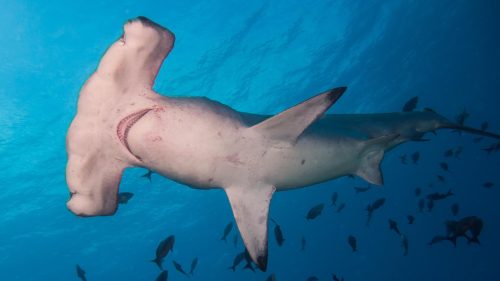
Scalloped hammerhead shark (Sphyrna lewini) (Photo Credit : Kris Mikael Krister)
Hammerhead sharks typically live in small groups, swimming together to corral small fish, shrimp, and squid, which are their primary food sources. The unique hammer-shaped head helps hammerhead sharks detect movements and vibrations in the water around them, making it easier for them to locate and capture prey.
Although they may appear intimidating, hammerhead sharks rarely attack humans unless they feel threatened. However, this species is unfortunately one of the primary targets in the illegal and highly profitable shark fin trade. Effective conservation and management efforts are crucial to preserving hammerhead sharks in Indonesian waters.
The presence of hammerhead sharks on coral reefs is vital for maintaining the balance of marine ecosystems. As apex predators, they help control the population of their prey, ensuring the stability of the food chain. Therefore, habitat preservation and protection of hammerhead sharks must be a top priority in marine conservation efforts in Indonesia.
- Reef Sharks (Carcharhinus spp.)
Reef sharks are one of the main inhabitants of coral reefs in Indonesia's tropical waters. The genus Carcharhinus includes a variety of shark species well adapted to reef environments, such as the blacktip reef shark, grey reef shark, and whitetip reef shark.
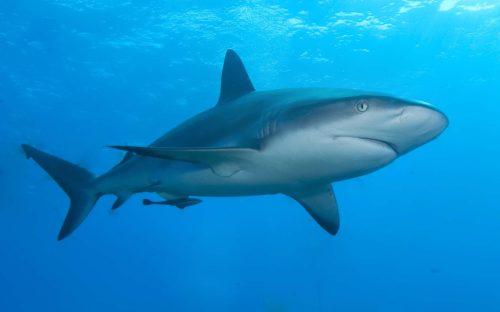
Caribbean reef shark (Photo Credit : Albert kok)
Reef sharks are generally medium-sized, with a body length of about 1-2 meters. They are aggressive and territorial, guarding their territory on the coral reefs. These sharks use their senses of taste, smell, and vibration detection to hunt prey like small fish, shrimp, and squid.
- Great White Shark (Carcharodon carcharias)
The great white shark, often referred to as the great white, is one of the most feared marine predators in the world. This large species can reach a body length of up to 6 meters and weigh up to 5 tons. With sharp teeth and powerful jaws, the great white can crush and prey on large animals such as tuna, whales, and sometimes even humans.
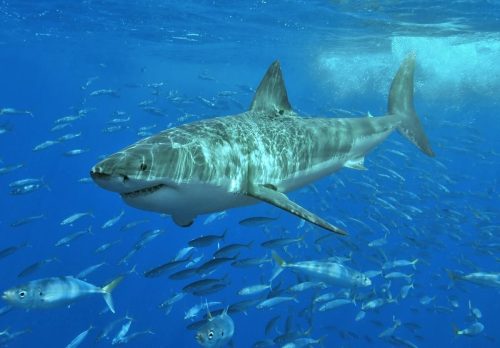
Great white shark at Isla Guadalupe, Mexico (Photo Credit : Terry Goss)
Great white sharks typically inhabit warm and temperate waters worldwide, including some areas of Indonesian waters. They swim solitarily or in small groups, using their keen senses to detect prey from long distances.
Despite their fearsome reputation, great white sharks rarely attack humans unprovoked. However, accidental encounters between great whites and humans in the water often end tragically, which is why great whites are often labeled as "killers" in popular culture.
Shark Populations in Indonesia
According to recent data from conservation organizations, the shark population in Indonesia is currently in a concerning state. Various shark species found in Indonesian waters have experienced significant population declines over the past few decades.
The IUCN (International Union for Conservation of Nature) assessment indicates that several shark species in Indonesia, such as hammerhead sharks, whale sharks, and reef sharks, are categorized as "Endangered" or "Vulnerable." The primary causes of shark population decline in Indonesia are unsustainable fishing practices, illegal shark fin trade, and habitat degradation due to human activities.
Shark Conservation Efforts
Various international, regional, and national conservation organizations are actively involved in preserving shark species. Global organizations like the IUCN conduct in-depth research to assess the conservation status of various shark species and compile the Red List for threatened species. Meanwhile, regional and national conservation organizations monitor shark populations in specific areas and develop conservation action plans tailored to local conditions.
Shark conservation efforts are also supported by international and national protection regulations and policies. International trade conventions like CITES (Convention on International Trade in Endangered Species of Wild Fauna and Flora) regulate the global trade of sharks and their derivatives to prevent overexploitation. Nationally, many countries have enacted laws and regulations prohibiting the capture, trade, and exploitation of sharks and have established protected areas and marine parks as safe habitats for shark populations.
Additionally, community involvement is crucial in shark conservation efforts. Campaigns to change the public's negative perception of sharks and disseminate information about their importance to ecosystems are key focuses in raising public awareness. Local communities are also directly involved in monitoring shark populations, patrolling, and supervising protected areas. Financial support and voluntary participation from the community in shark conservation activities also contribute to the preservation efforts of these species.
References
Megalodon: Largest Shark that Ever Lived." Florida Museum
A Complete Guide & Timeline of Prehistoric Sharks | Dinosaur Documentary
IUCN Red List of Threatened Species. (2022)
White, W. T., Fahmi, & Dharmadi. (2015). Sharks and Rays of Indonesia. CSIRO Publishing.
Kompas. (2018). Panduan Lapangan Ikan Hiu dan Pari di Indonesia. Kompas.
"Ikan Hiu di Indonesia." Kementerian Kelautan dan Perikanan

